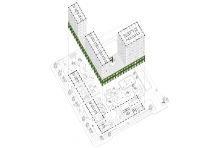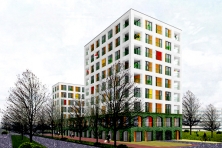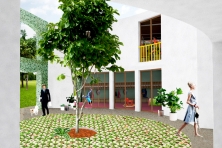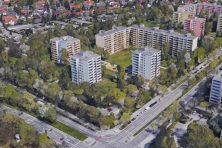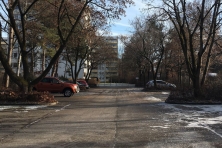New Proximities
München/Taufkirchen (DE) - Mentionné
DONNÉES DE L’ÉQUIPE
Représentant d’équipe: Federico Cheloni (IT) – architecte
Associés: Enrico Casagni (IT), Matteo Chelazzi (IT), Giulio Margheri (IT) – architectes
Via G. Sirtori 36, 50137 Firenze (IT)
info@caretstudio.eu - carestudio.eu
Voir la liste complète des portraits ici
Voir la page du site en anglais ici

G. Margheri, E.Casagni, M. Chelazzi et F. Cheloni
INTERVIEW en anglais
Cliquer sur les images pour les agrandir
1. How did you form the team for the competition?
The team already existed before taking part in the competition. We met at the university of Florence, from which we all graduated in 2013. Since then we have pursued an in-depth collaboration, and in 2017 we gave some additional structure to the collective, founding Càret.eu. Currently we are all based in different cities, but we constantly engage in a variety of projects such as competitions, workshops or specific assignments.
2. How do you define the main issue of your project, and how did you answer on this session main topic: the place of productive activities within the city?
Our project is a reflection on our way of living and on the needs of contemporary (European) cities. The diversification of services and the dependence on electronic devices have made the physical boundaries between work and living space increasingly blurred, pushing production activities into fluid spaces and places within cities. The project challenges mono-functional districts that, over the past years, turned entire areas of the city into dormitory neighbourhoods. “New proximities” aims to spark a process of functional diversification in which the coexistence of living and working spaces generates a series of qualities and convenience that will stimulate a greater social diversification.
3. How did this issue and the questions raised by the site mutation meet?
The four sites of München/Taufkirchen are characterized by a clear mono-functionality. The idea to propose as a new model of the productive city allowing us to break the existing logic and insert productive activities in proximity to the houses. The need for spaces, adapting to ever-changing needs, has been addressed by seeking the greatest flexibility in space and time: the podium is a flexible entity that accommodates work spaces and common areas but can take on many other configurations and uses. Moreover, it establishes a fluid relationship between the interior and the exterior through the creation of a collection of in-between spaces.
4. Have you treated this issue previously? What were the reference projects that inspired yours?
The theme of housing has been repeatedly tackled and interpreted in different ways, both with the offices we work with and in our projects as a collective. The references, although not explicit, are multiple, ranging from the historic Italian and Bavarian cities, where a building’s ground floor was often given to commercial activities, workshops and meeting spaces, to the most recent office projects that embrace new forms of work and consequently uses of the space. Another set of relevant references were the modernist experiment of social housing where there was an attempt to combine quality with a high level of technology and efficiency.
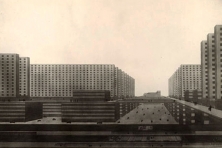
5. Urban-architectural projects like the ones in Europan can only be implemented together with the actors through a negotiated process and in time. How did you consider this issue in your project?
We consider flexibility as the key adapting the idea to different contexts, situations and questions. Our project is based on simple and clear principles, meaning that in a process of negotiation with local authorities or in participatory design forms with different actors, the project can only grow and improve, without losing its nature. The project was conceived with two clear identities, and it is based on this principle that the transformation of its use is not only permitted but encouraged.
6. Is it the first time you have been awarded a prize at Europan? How could this help you in your professional career?
Upon graduation, we received a special mention in Europan 12, dealing with another site in Münich. The Europan competition was followed by second phase, launched by the owner of the area, where we earned first prize and the proposal was finally acquired by the client himself. It was a moment of great growth and challenge, especially for our organization as a collective: when we were invited to the second phase we were all scattered in four different cities. We believe that Europan represents an extraordinary opportunity for collaboration among emerging professionals across Europe, we believe that it can also represent an important step in the construction of our professional future.
